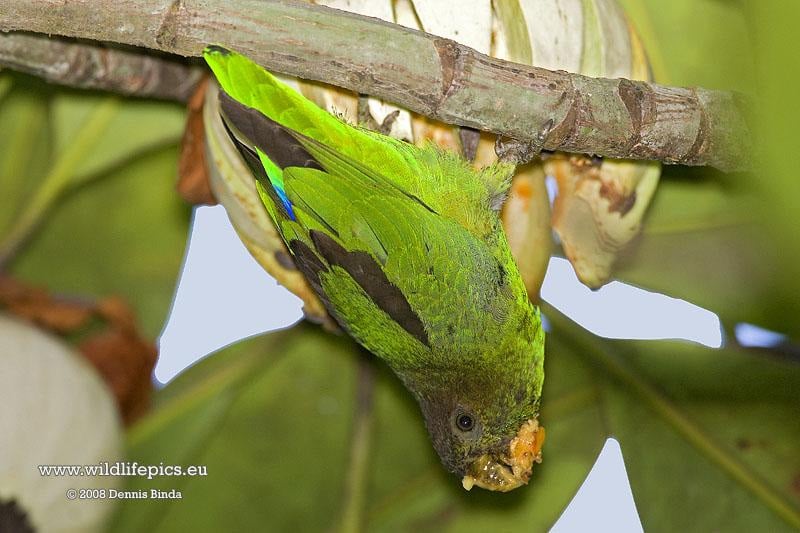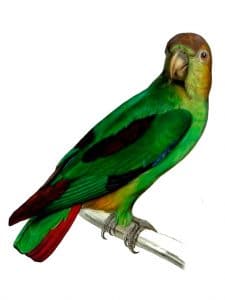Content |
|---|
Description:
18 cm.. height
The Sapphire-rumped Parrotlet (Touit purpuratus) has the forecrown, crown, ear-coverts and sides neck, color marron-oliva; lores and cheeks green; rear area of the neck of color green pale with broadcasting brownish. Mantle and top of the back, green; scapulars and tertiary, dark brown; rump blue; uppertail-coverts green.
Feather blue in it bend of wing; primary coverts brown-black, rest of the coverts green. The flight feather Brown by up in innerwebs and tips, Yes no green; pale green blue for below. Underwing-coverts green. The underparts pale, of color green emerald slightly yellowish, with a layer of ochre in the sides of the belly. The tail Le da an appearance unmistakable, with black edge, green in the center and dark crimson on the sides, with black margins to outerwebs.
Bill off-white color pale Horn-tipped up to the upper jaw; irises black; legs grey.
The female has the tail (except central feathers) with the subterminal band green. Immature more yellowish below; the black color in the tail confined to the tips; Green olive from the forecrown up to the nape and ear-coverts lower.
- Sound of the Sapphire-rumped Parrotlet.
Description 2 subspecies:
-
Touit purpuratus purpuratus
(Gmelin, 1788) – Nominal.
-
Touit purpuratus viridiceps
(Chapman, 1929) – As the nominal species but with the forecrown, crown and back neck, green; flanks with less yellowish green and feathery external of the tail showing a purple glow.
Habitat:
Species Rare and hard to see.
It inhabits, mainly, in the humid lowland canopy and forests and marshes, also observed in savanna in Suriname. In lower and more open to high altitude forests in Venezuela and in isolated areas cleared forests. Reports in altitudes of 400 metres in Colombia, and 1.200 metres in Mount Duida, Venezuela. gregarious, usually in groups of 12-40 birds.
Reproduction:
Observed the female digging a hole in a tree of forests and marshes in the month of November in Colombia; Birds in a nest in termitario tree in the month of April in Suriname, and males in breeding condition in the month of March in Venezuela. The laying tends to be of 3-5 eggs.
Food:
Observed eating fruit of Clusia grandiflora, Pouroma guianensis and Ficus figs and feeding on trees of Sapotaceae and Myrtaceae. Mainly forage in the canopy, Although also observed in low bushes and occasionally Earth.
Distribution:
Size of the area of distribution (reproduction / resident): 4.550.000 km2
It inhabits in the North of South America, mainly in the Basin Amazon, from the north end of Peru, east of Ecuador (Pastaza) and Colombia to the East of the Andes in West Caquetá (for example, Three corners) and the southeastern tip of Guainia (along the Black river) to the South of the Brazilian Amazon until For and North of maranhão, to the North of the Amazon and along the Vaupes River and the icana river through the basin of the Black river until Manaus; then through the South of Venezuela from amazon along the Orinoco to the South from the Ventauri River, in the Cerro Yapacana National Park and Mount Duida and from the South of Bolívar in the Tepuyes of the Gran Sabana and Caura River, in Guyana, Barima, rivers Mazaruni and Chamber and to the South up to Bartica.
Comes to be local in Suriname and French Guiana. Discrete, often difficult to observe and apparently sparsely populated in most parts of its range. Perhaps more numerous in those sections more low of it amazon basin.
Distribution 2 subspecies:
-
Touit purpuratus purpuratus
(Gmelin, 1788) – Nominal. Southeast of amazon in Venezuela, up to the Guianas and this from the Basin of the Amazon in Brazil.
-
Touit purpuratus viridiceps
(Chapman, 1929) – Black river, the Northwestern basin of Brazil, Venezuela West from Mount Duida until Colombia, Ecuador and Peru.
Conservation:
State of conservation ⓘ |
||
|---|---|---|
 Minor Concern ⓘ
(UICN)ⓘ
Minor Concern ⓘ
(UICN)ⓘ
| ||
• Current category of the Red List of the UICN: Least concern.
• Population trend: Stable.
Justification of the population
The size of the world's population has not been quantified, but this species is described as “Rare” (Stotz et to the., 1996).
Justification of trend
It is suspected that this species has lost 12,8-15,2% of habitat within its distribution over three generations (15 years) starting from a model of deforestation Amazon (Soares-Filho et to the., 2006, Bird et to the., 2011). Given the susceptibility of the species to hunting and / or capture, It is suspected that it will fall in <25% during three generations.
In captivity:
Very rare in captivity.
Alternative names:
– Sapphire-rumped Parrotlet, Purple Guiana Parrotlet, Sapphire rumped Parrotlet (English).
– Toui à queue pourprée (French).
– Purpurschwanzpapagei, Purpurschwanz, Purpurschwanz-Papagei (German).
– Apuim-de-costas-azuis, apuim-de-costa-azul, periquitinho (Portuguese).
– Cotorrita Purpurada, Lorito de Lomo Purpúreo, Periquito Zafiro (español).
– Periquito Zafiro (Colombia).
– Periquito de Lomo Zafiro (Peru).
– Periquito Rabadilla Púrpura (Venezuela).
– Periquito lomizafiro (Ecuador)
scientific classification:

– Order: Psittaciformes
– Family: Psittacidae
– Genus: Touit
– Scientific name: Touit purpuratus
– Citation: (Gmelin, JF, 1788)
– Protonimo: Psittacus purpuratus
Images Sapphire-rumped Parrotlet:
Videos of the "Sapphire-rumped Parrotlet"
Sapphire-rumped Parrotlet (Touit purpuratus)
Sources:
- Avibase
- Parrots of the World – Forshaw Joseph M
- Parrots A Guide to the Parrots of the World – Tony Juniper & Mike Parr
- Birdlife
-
Photos:
(1) – wildlifepics.eu © 2008 Dennis Binda
(2) – Touit purpuratus By P. Bertrand [Public domain], via Wikimedia Commons
- Sounds: (Xeno-canto)
Of 18 cm.. tall Inconfundible by the ends of the tail, which are dorsally and ventrally purple-red with black border.
Overall green body with Brown Crown and nape, wing with both opaque Brown ends and violet blue rump.
Female with paler brown head and green-streaked tail.
The subspecies T. p. viridiceps has a totally green head.
Uncommon and difficult to observe species.
Lives in humid forests, semi-humid and swampy, until the 400 m. It forms small groups and they are silent when they feed. It nests in hollows of trees or arboreal termiteros at low altitude. The implementation is of 3-5 eggs and breeding season: from November to April
It is found in the wild in the Amazon, South-East of Colombia to the Guyanas, southern Venezuela to northeastern Peru and northern Brazil.
It feeds on fruits, and figs.
Video: Video 1
Deforestation and loss of Habitat is a threat for this species.
Alternative names: Sapphire-rumped Parrotlet (English), Periquito zafiro (Colombia), Periquito lomizafiro (Ecuador), Purpurschwanz, Purpurschwanzpapagei (Germany), Lorito de Lomo Purpúreo (Spain), Periquito Rabadilla Púrpura (Venezuela), Toui à queue pourprée (France), apuim-de-costa-azul (Brazil)
Source: Parrots, Parrots and macaws Neotropical
Photo: wildlifepics.eu © 2008 Dennis Binda


